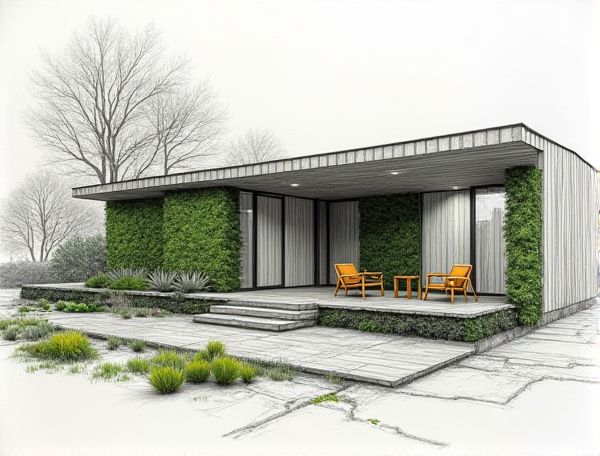
Photo illustration: Biophilic home design with vertical moss walls
Incorporating vertical moss walls into your home design enhances indoor air quality and brings a natural, calming aesthetic that fosters well-being and creativity. Explore the full article to discover how biophilic design can transform your living spaces into green, serene environments.
Introduction to Biophilic Home Design
Biophilic home design integrates natural elements like plants, sunlight, and organic materials to create a harmonious living environment that enhances well-being. Incorporating features such as green walls, natural light optimization, and wood textures fosters a strong connection between occupants and nature. This design approach not only improves air quality but also reduces stress, promoting a healthier and more sustainable lifestyle in residential spaces.
Understanding Vertical Moss Walls
Vertical moss walls enhance your interior with natural textures and improved air quality, offering a low-maintenance, eco-friendly design element that adapts well to various lighting conditions. These living walls utilize preserved moss, which requires no soil or sunlight, providing a sustainable and visually striking feature for any home design.
Benefits of Integrating Nature Indoors
Integrating nature indoors enhances air quality by introducing plants that naturally filter pollutants and increase oxygen levels, promoting a healthier living environment. Natural elements such as wood, stone, and water features create a calming ambiance, reducing stress and improving mental well-being. Your home benefits from increased aesthetic appeal and a stronger connection to the outdoors, fostering relaxation and productivity.
Key Elements of Biophilic Interiors
Natural light, indoor plants, and organic materials are essential key elements of biophilic interiors that enhance your connection to nature and improve well-being. Incorporating water features, textured surfaces, and natural patterns further enriches the sensory experience, creating a harmonious and restorative living space.
Selecting the Right Moss for Your Wall
Choosing the right moss for your wall involves considering factors such as light exposure, humidity levels, and maintenance requirements to ensure optimal growth and durability. Your selection should prioritize species like sheet moss or reindeer moss, known for their vibrant appearance and resilience in indoor environments.
Installing Vertical Moss Walls at Home
Installing vertical moss walls enhances indoor air quality by naturally filtering pollutants and increasing humidity. These living walls require minimal maintenance, thrive in low-light environments, and add a unique biophilic element to modern home designs. Incorporating vertical moss walls also provides sound insulation, making them ideal for creating peaceful, stylish living spaces.
Maintenance Tips for Moss Walls
Regularly misting moss walls helps maintain their vibrant green appearance and prevents drying out. Keeping your moss wall away from direct sunlight and harsh drafts ensures optimal humidity levels for longevity. You should also gently dust the moss occasionally to remove debris and preserve its natural texture.
Biophilic Design for Health and Well-being
Biophilic design integrates natural elements such as greenery, natural light, and organic materials to enhance your home's air quality and reduce stress levels. Incorporating biophilic principles supports mental clarity, boosts mood, and promotes overall well-being by creating a harmonious connection between indoor spaces and the natural environment.
Creative Ideas for Moss Wall Placement
Incorporating moss walls in your home design enhances both aesthetics and air quality, especially when placed in living rooms, bathrooms, or entryways where natural light is ample but indirect. Your creative placement can transform blank walls into vibrant focal points, using variations in moss types and shapes to add texture and a calming natural element to your space.
Sustainable Living through Biophilic Design
Incorporating biophilic design into home environments enhances sustainable living by seamlessly integrating natural elements such as indoor plants, natural light, and organic materials. This approach not only reduces energy consumption by improving air quality and thermal regulation but also promotes occupants' well-being by fostering a strong connection to nature. Utilizing renewable resources and maximizing natural ventilation further supports eco-friendly home design while creating aesthetically pleasing and healthful living spaces.
 homedesy.com
homedesy.com